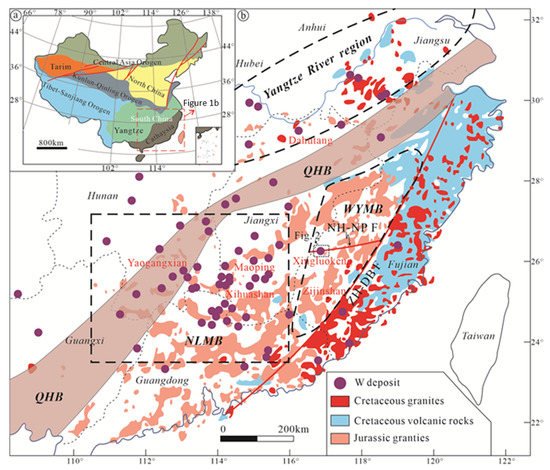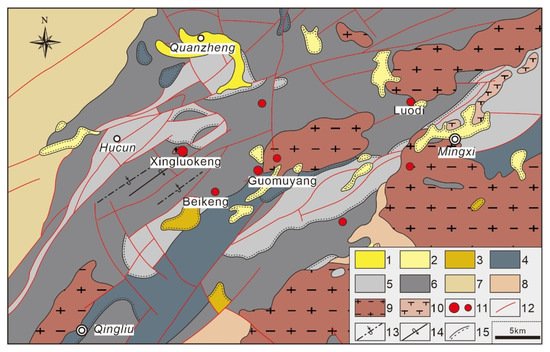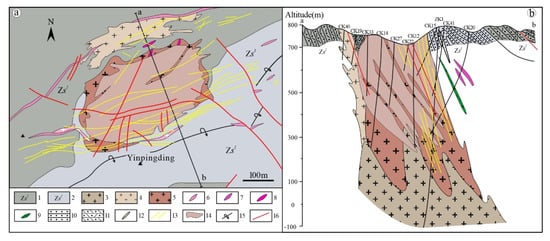TChe He-Ar isotopic compositions showed that theina has the largest W 3Hre/4Hse ratios of the ore-forming fluid of the Xingluokeng deposit ranged from 0.14 to 1.01 Ra (Ra is thves in the world, which are mainly concentrated in south China. Although previous studies have 3Hbe/4Hen ratio of air, 1 Ra = 1.39 × 10−6), wicarried outh an average of 0.58 Ra, which is between the 3He/4He on whetheratios of mantle fluids and crustal fluids, suggesting that the mantle-derived He was added to the mineralizing fluid, with a mean of 8.7%. Thematerial is incorporated in granites associated with W deposits, the conclusions have been inconsistent. However, 40Ar/36Aare ratios of these samples ranged from 361 to 817, with an average of 578, between the atmospheric 40Ar/36Ar agas isotopes can be used to study the contribution of mantle-to-W mind the crustal and/or mantle 40Ar/36Arralization.
1. Introduction
China has the largest tungsten reserves in the world, with approximately 10.3 million tons of WO
3 [1][2][1,2], and most of the W deposits are mainly clustered in south China (
Figure 1), which accounts for about 80% of the country’s total and around 50% of the world’s total
[3][4][5][6][7][8][3,4,5,6,7,8]. The formation of W deposits in south China is mainly related to the Mesozoic (concentrated in 160~150 Ma) magmatic activity
[9][10][9,10], and most of the W deposits in south China are concentrated in the Nanling metallogenic belt (NLMB). Traditionally, most W-related granites are considered as S-type granites, derived from the reworking of ancient meta-sedimentary rocks
[11], and it is thus assumed that tungsten mineralization occurred without the addition of mantle material, but recent studies suggest that these granites may be mainly I-type granites
[12][13][12,13]. The reason for the controversy is that the granites associated with tungsten mineralization are mainly high-differentiated granites, which makes it difficult to classify the genetic types and evaluate the influence of mantle on tungsten mineralization.
Figure 1. (
a) Tectonic map of China. (
b) Geologic map showing the distribution of Mesozoic granitoids and major tungsten deposits in south China (modified after
[14][15][16][14,15,16]). NLMB = Nanling metallogenic belt, QHB = Qin-Hang metallogenic belt, WYB = Wuyi metallogenic belt, ZH-DB F = Zhenghe-Dabu fault, NH-NP F = Ninghua-Nanping fault.
Due to the distinct
3He/
4He ratios of the crust (~0.05–0.01 Ra, where Ra is the atmospheric
3He/
4He ratio, 1.39 × 10
−6) and upper mantle (6–9 Ra), and different
40Ar/
36Ar ratio of the atmosphere (295.5) versus the crust or mantle, the He-Ar isotopic compositions of fluid inclusion in minerals have been widely used in the studies of contribution of mantle-derived components and the relationship between crust–mantle interactions and mineralization
[17][18][19][20][21][17,18,19,20,21]. Recently, a growing number of studies have used the method of He-Ar isotopes to prove that mantle-derived components were involved in the genesis of some W deposits (such as the Gerês W deposit
[22] and Panasqueira W deposit
[20] in Portugal, Dae Hwa W deposit in South Korea
[23], and Xihuashan
[24], Yaogangxian
[18], Shizhuyuan
[25], Piaotang
[26], Taoxikeng
[27], Yaoling-Meiziwo
[28], and other W deposits in south China).
The Xingluokeng W-Mo polymetallic deposit is one of the superlarge W deposits in China and the largest W deposit in the Wuyi metallogenic belt (WYMB), which is historically a Cu-dominated polymetallic belt
[10][29][10,29]. Many researchers have studied the petrographic geochemical characteristics
[30][31][32][30,31,32], deposit geochemical characteristics
[33][34][33,34], and geochronology
[2][35][2,35]. However, whether mantle components are involved in the genesis of the deposit is poorly studied understood.
2. Geological Background
The south China block is composed of the Yangtze block to the northwest and the Cathaysia block to the southeast, separated by the Qin-Hang belt
[36]. Around 900 Ma ago, the paleo South China Ocean gradually closed, resulting in the collision of Yangtze and Cathaysian blocks on both sides of the ocean basin, forming an arc-shaped orogenic belt with a width of more than 100 km and an extension of about 1500 km at the junction, i.e., Qin-Hang belt
[37][38][37,38]. The geological background of south China is complex, with strong tectonic movements
[39][40][39,40] and a wide distribution of granites of different ages and types, which are known for large-scale magmatic activities and mineralization events in the Mesozoic, forming huge deposits of W, Sn, U, and REE
[7][41][42][43][44][45][7,41,42,43,44,45].
The WYMB is located in the northeast of the Cathaysian block and distributed in the NNE direction (
Figure 1), bounded on the north by the Shaoxing-Jiangshan-Pingxiang fault and adjacent to the Qinhang metallogenic belt on the southeast edge of the Yangtze block, on the west by the Yingtan–Anyuan fault, near the NLMB, and on the east by the Lishui-Zhenghe-Dapu fault to the southeast coastal metallogenic belt
[46][47][46,47]. The WYMB has experienced major geological events such as the formation and cracking of the Cathaysian block, the collision and splicing of the Cathaysian block and the Yangtze block, the collision between the north China block and south China block, and the subduction of the Pacific plate to the Eurasian continental margin, among which the Yanshanian tectonic magmatic activity is the strongest
[48][49][48,49], and forming a large number of Cu, Au, Ag, Pb, and Zn deposits
[50][51][52][53][50,51,52,53], such as the Zijinshan Cu–Au deposit and the Lengshuikeng Ag–Pb–Zn deposit, as well as some large W deposits, such as the Shangfang W deposit and Xingluokeng W-Mo deposit. The strata in WYMB include the upper Archean to Quaternary, in which the pre-Devonian is the basement rock series, the Devonian Middle Triassic is the caprock rock series dominated by marine sedimentation, and the Meso Cenozoic is the continental clastic and volcanic rock series. The fault is mainly NNE-trending, followed by NW-trending, and partly NEE-trending. The study area is located in the western part of the NEE-trending Nanping-Ninghua fault zone (
Figure 1). In addition to the Xingluokeng deposit, there are also tungsten deposits and mineralized sites in the zone, such as Beikeng and Guomuyang (
Figure 2).
Figure 2. Regional geological map of the Xingluokeng W-Mo ore field showing W deposits in the area (modified after
[46]). 1 = quaternary; 2 = tertiary; 3 = cretaceous; 4 = Jurassic System; 5 = Upper Devonian–Permian; 6 = Upper Sinian-Lower Cambrian; 7 = Caledonian gneissic biotite monzogranite; 8 = Indosinian gneissic biotite monzogranite; 9 = Yanshanian biotite granite; 10 = Yanshanian syenite; 11 = W deposit and mineralization point; 12 = fault; 13 = axis of overturned synclinal; 14 = axis of overturned anticline; and 15 = unconformity boundary.
3. Deposit Geology
The Xingluokeng W deposit is located about 35 km northeast of Ninghua County, western Fujian Province, and is the largest tungsten deposit in Fujian Province, featured by large reserves (~30 Mt of WO
3) and low grade (averaging at 0.23%). In addition to W, the reserves of Mo are 3.02 Mt with an average grade of 0.024%. With the deepening of the mining depth (the current mining depth is about 600 m elevation), Cu has also reached the industrial grade, the available exploration data show that there is still tungsten mineralization at 100 m elevation, and the Xingluokeng pluton is characterized by whole rock mineralization
[32].
The outcropped stratigraphic sequences in the area are mainly Sinian Sanxizhai Formation (Z
2s) and Middle Devonian Tianwadong Formation (D
3t). The Sanxizhai Formation (Z
2s) comprises three sections from the bottom up: metamorphic siltstone with lenticular carbonates (Z
2s
1), metamorphic feldspar quartz sandstone (Z
2s
2), and metamorphic fine sandstone and siltstone (Z
2s
3). The NEE-trending Xingluokeng inverted anticline (dips to SE with an inclination of 43°–63°) controls the distribution of main stratigraphic units, with the first section (Z
2s
1) occurring at the core and the second section (Z
2s
2) at the wings. NEE-trending faults, as the dominant regional structures, control the emplacement of the Xingluokeng stock and are the main ore-hosting structures for large quartz vein-type ore bodies. A series of NW-trending faults was also developed, cross-cutting the Xingluokeng stock and the NEE-trending faults in addition to a number of near SN-trending faults (
Figure 3). The Xingluokeng stock is composed of porphyritic biotite granite (G1) and medium- to fine-grained biotite granite (G2), which intruded into the north wing of overturned anticline along the interface between the first section and the second section of the Sanxizhai Formation
[33]. The zircon U-Pb ages indicated they were emplaced at 152.5 ± 1.4 Ma and 152.2 ± 1.2 Ma and the geochemical data indicated that G2 is a moderately to highly fractionated I-type granite
[30]. The late-stage granite porphyry and aplitic dikes are well developed in the mining area (
Figure 3).
Figure 3. (
a) Geological map of the Xingluokeng W-Mo polymetallic deposit (modified after
[2]). (
b) A NNW-SSE trending cross-section of the Xingluokeng W-Mo polymetallic deposit (modified after
[33]). 1 = the second section of Sanxizhai Formation; 2 = the first section of Sanxizhai Formation; 3 = early Yanshanian fine-grained porphyritic granite; 4 = early Yanshanian fine- to medium-grained granite; 5 = early Yanshanian porphyritic biotite granite; 6 = granite-porphyry dyke; 7 = aplite dyke; 8 = borengite dyke; 9 = sillite dyke; 10 = hornfelsic metamorphic siltstone; 11 = hornfelsic tuff; 12 = dolomite limestone; 13 = mineralized quartz veins; 14 = axes of reverse anticline; and 15 = fault.
Two major mineralization styles have been identified at Xingluokeng: veinlet-disseminated and vein-type mineralization. The veinlet-disseminated mineralization mainly consists of disseminated molybdenite, scheelite, and wolframite, as well as minor pyrite and chalcopyrite in coexistence with quartz, beryl, fluorite, and muscovite, which are densely distributed in the altered granite and sparsely in the country rocks. The vein-type mineralization cross-cuts the veinlet-disseminated mineralization with ore minerals of wolframite, scheelite, and sulfides, in coexistence with quartz, K-feldspar, beryl, muscovite, fluorite, and calcite. Potassic alteration and greisenization are intensive and pervasive within the main orebody, overprinted by phyllic alteration, silicification, chloritization, and carbonatization assemblages. The Re-Os age of molybdenite was 156.3 ± 4.8 Ma
[2] and the U-Pb age of wolframite were 151.3 ± 5.8 Ma and 150.5 ± 8.1 Ma
[35].
The consistency of the chondrite-normalized REE distribution pattern of scheelite and mineralization-related granite in the Xingluokeng tungsten deposit indicated that the ore-forming fluid is mainly derived from the exsolution of magmatic fluid
[33]. H-O and Sr isotopic compositions also suggested the ore-forming fluids dominantly originated from magma and limited meteoric water involved in the late mineralization stage
[33].



